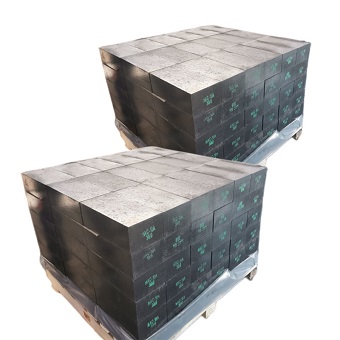Application of magnesia carbon refractory bricks in various parts of converter lining
In the smelting process, the use conditions and damage conditions of each part of the converter are different. For each part of the converter with varying conditions of use, the refractory materials to be built are also different.
(1) Furnace mouth: Because the temperature of the furnace mouth changes drastically, the slag and high-temperature exhaust gas are significantly eroded, and the furnace mouth is impacted when removing scrap steel and charging, so the refractory material used for the furnace mouth must have high resistance. Thermal shock resistance and slag resistance must be resistant to erosion by slag and high-temperature exhaust gas, and it is not easy to hang steel and easy to clean.
(2) Furnace cap: The furnace cap is the part that is more severely corroded by slag and is also affected by temperature changes, as well as carbon oxidation and scouring of dusty exhaust gas, so it is necessary to use strong slag resistance and thermal shock resistance. Magnesia carbon brick.
(3) Charging side: The splashing effect of slag and molten steel during blowing is easy to cause chemical erosion, wear, and erosion on the charging side, and the charging side is also directly impacted and eroded by the scrap and molten iron charging, resulting in Severe mechanical damage requires magnesia-carbon bricks not only have high slag resistance and high-temperature strength but also must have very good thermal shock resistance.

(4) Tapping side: magnesia carbon refractory bricks the tapping side is basically free from mechanical damage during charging, and the thermal shock is less affected. However, due to the thermal shock and scouring of molten steel during tapping, the damage speed is much smaller than that of the charging side. When using the same material as the charging side, in order to maintain the balanced life of the converter charge, a structure with a thinner thickness than the charging side is used for masonry.
(5) Slag line part: The slag line is the part where the charge and the molten slag are in contact for a long time and are seriously corroded by slag. On the slag discharge side, due to the combined influence of strong slag corrosion and other effects on the belly position during the blowing process, the damage is serious, so it is necessary to build magnesia-carbon bricks with excellent slag resistance.
(6) Both sides of the trunnion: Except for the damage caused by blowing, the surface of the two sides of the trunnion is not covered by a protective layer, which is not easy to repair. Therefore, the carbon in the charge material is easily oxidized, so the damage is serious and should be masonry. High-grade magnesia-carbon bricks with excellent slag resistance and strong oxidation resistance.
(7) Hearth and hearth: These parts are severely scoured by molten steel during blowing, but compared with other parts, the damage rate is lower, so magnesia-carbon bricks with low carbon content or tar dolomite bricks can be used.
-

Silicate fire brick
Silicon thermal insulation refractory brick refers to the thermal insulation refractory products made of silica as the main raw material, with a SiO2 content of no less than 91%. In addition to the heat insulation perfor··· -

silica bricks manufacturing process
1.1 Determination of raw material ratio and particle compositionThe raw materials for making silica bricks are silica and waste bricks containing more than 96% SiO2, in addition to lime, mineralizers and organic binders.··· -

Alumina hollow ball bricks
Alumina hollow ball bricks are made of alumina hollow balls and alumina powder as the main raw materials, combined with other binders, and fired at a high temperature of 1750 degrees. It belongs to a kind of ultra-high t··· -

Anti-stripping high alumina brick for cement kiln
Anti-stripping high alumina bricks are made of high alumina bauxite clinker, mullite, kyanite, zircon sand, and binder first through granulation and powdering processes, mixed in a certain proportion, then pressed into s···

